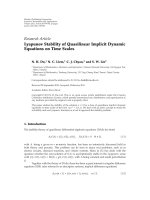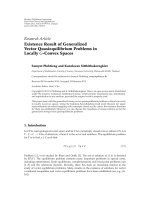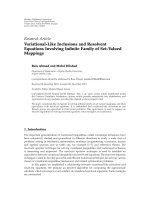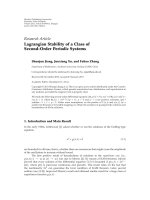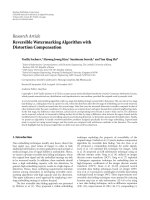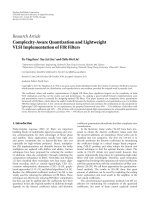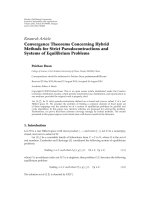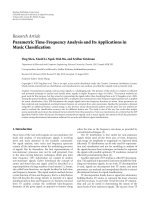Báo cáo hóa học: " Research Article Uplink Cross-Layer Scheduling with Differential QoS Requirements in OFDMA Systems" docx
Bạn đang xem bản rút gọn của tài liệu. Xem và tải ngay bản đầy đủ của tài liệu tại đây (778.16 KB, 10 trang )
Hindawi Publishing Corporation
EURASIP Journal on Wireless Communications and Networking
Volume 2010, Article ID 168357, 10 pages
doi:10.1155/2010/168357
Research Article
Uplink Cross-Layer Scheduling with Differential QoS
Requirements in OFDMA Systems
Bo Bai,
1, 2
Wei Chen,
2
Zhigang Cao,
2
and Khaled Ben Letaief
1
1
Department of Electronic and Computer Engineering, The Hong Kong University of Science & Technology, Clear Water Bay,
Kowloon, Hong Kong
2
Department of Electronic Engineering, Tsinghua National Laboratory for Information Science and Technology (TNList),
Tsinghua University, Beijing 100084, China
CorrespondenceshouldbeaddressedtoBoBai,
Received 15 January 2010; Revised 29 June 2010; Accepted 21 September 2010
Academic Editor: Mohammad Shikh-Bahaei
Copyright © 2010 Bo Bai et al. This is an open access article distributed under the Creative Commons Attribution License, which
permits unrestricted use, distribution, and reproduction in any medium, provided the original work is properly cited.
Fair and efficient scheduling is a key issue in cross-layer design for wireless communication systems, such as 3GPP LTE and
WiMAX. However, few works have considered the multiaccess of the traffic with differential QoS requirements in wireless systems.
In this paper, we will consider an OFDMA-based wireless system with four types of traffic associated with differential QoS
requirements, namely, minimum reserved rate, maximum sustainable rate, maximum latency, and tolerant jitter. Given these
QoS requirements, the traffic scheduling will be formulated into a cross-layer optimization problem, which is convex fortunately.
By separating the power allocation through the waterfilling algorithm in each user, this problem will further reduce to a kind of
continuous quadratic knapsack problem in the base station which yields low complexity. It is then demonstrated that the proposed
cross-layer method cannot only guarantee the application layer QoS requirements, but also minimizes the integrated residual
workload in the MAC layer. To further enhance the ability of QoS assurance in heavily loaded scenario, a call admission control
scheme will also be proposed. The simulation results show that the QoS requirements for the four types of traffic are guaranteed
effectively by the proposed algorithms.
1. Introduction
Orthogonal frequency-division multiple access (OFDMA)
offers a very attractive solution in providing high perfor-
mance and flexible deployment for broadband wireless access
network. In particular, OFDMA provides at more degrees
of freedom for multiuser systems. The subcarriers can be
allocated dynamically at different time instances to exploit
the multiuser diversity [1] and frequency diversity [2], and
adaptive power allocation can also be applied to further
improve the power efficiency [3]. To enhance the efficiency
and fairness, OFDMA also allows us to schedule time-
domain resources, referred to as timeslots.
The typical OFDMA systems in wireless communications
are 3GPP LTE-based cellular system [4] and IEEE 802.16
protocol-based WiMAX system [5]. These newly emerging
systems provide a platform for applying the cross-layer
resource allocation and scheduling technology. These sys-
tems are designed as a unified wireless access system to sup-
port multiple types of traffic, such as voice, data, audio/video,
multimedia, interactive game, and Internet access. Thus, how
to jointly use these technologies in the physical (PHY) layer
and MAC layer to support the trafficwithdifferential QoS
requirements in the application layer is a central problem in
OFDMA systems [6]. In this paper, we shall focus on this
problem and use a cross-layer optimization methodology to
provide a traffic scheduling method for supporting efficiently
multiplexing services with a variety of QoS requirements.
Due to the stochastic nature of the traffic arrival process
and the wireless channel, it is a challenging work to achieve
fair and efficient resource allocation and QoS-guaranteed
scheduling in OFDMA systems. In 1995, a joint-layer opti-
mization perspective was proposed by Telatar and Gallager
in [7]. Subsequently, Berry and Yeh put forward that the
future wireless communication system design needs cross-
layer optimization methodology [8]. They also discussed
2 EURASIP Journal on Wireless Communications and Networking
the cross-layer approach for wireless resource allocation in
multiaccess and broadcasting queueing systems, respectively.
Specifically, in order to collect all the parameters together in
the uplinks, one may formulate the system as a multiaccess
queueing system or generic switch model and consider
the weighted sum of the queue lengths, which is often
referred to as the integrated workload. More recently, Stolyar
proved the optimality of the MaxWeight scheduling in [9].
In [10], Mandelbaum and Stolyar extended this method
to the continuous strictly increasing convex function of
the queue length and proved the optimality of C
− μ law
scheduling. Based on the queueing theory and optimization
method, Niyato and Hossain studied the radio resource
management in IEEE 802.16 wireless broadband system
[11]. An alternative method to incorporate concerns and
constraints of various layers is to apply utility maximization
formulation. In [12], Song et al. used this method to obtain a
queue-aware and channel-aware scheduling algorithm, that
is, transmit the traffic which minimizes the average delay.
Based on the similar framework, Kulkarni and Rosenberg
studied the opportunistic scheduling framework of multiple
QoS requirements and short-term fairness in the system with
multiple wireless interfaces [13]. In [14], Fu et al. solved
the dual problems of maximizing expected throughput given
limited energy and of minimizing expected energy given the
minimum throughput constraint.
The above works have significantly enhanced the overall
performance of wireless communications. However, they
did not consider the scheduling problem of multiple types
of trafficwithdifferential QoS requirements, which is
a practical scenario in OFDMA wireless access network.
A typical OFDMA system, say IEEE 802.16 broadband
wireless access network, has multiple independent users
communicating with one base station (BS). There are four
types of traffic in IEEE 802.16 protocol, namely, best effort
service (BE), nonrealtime polling service (nrtPS), realtime
polling service (rtPS), and unsolicited grant service (UGS)
[5]. Any application-layer traffic must be classified into one
of these types, and its QoS requirements can be described
differentially by minimum reserved rate, maximum sustain-
able rate, maximum latency, and tolerant jitter. Thus, the
arrival trafficofeachuserwillbestoredindifferent buffers
and scheduled by a cross-layer scheduler in BS. Since the
OFDMA-based PHY layer is timeslotted, every user should
offer the traffic transmission request and its QoS parameters
at the beginning of each timeslot. Given the constraints of
QoS requirements and the instantaneous channel conditions,
the scheduler allocates subcarriers, power, and timeslots,
so as to transmit the trafficefficiently and guarantee the
differential QoS requirements.
In this paper, the integrated residual workload method
is introduced to cover the above considerations. By using
this method, the resource allocation and traffic scheduling
can be formulated into a cross-layer optimization problem
under the transmission rate constraints, which is convex
fortunately. Since the power allocation gives little advantage
in terms of ergodic capacity [15], we decompose the
power allocation from the original convex optimization
problem through the water-filling algorithm in each user.
The resulting optimization problem in BS, referred to as
the time-frequency allocation problem, is fortunately a
continuous quadratic knapsack problem with a generalized
upper bound and an angular structure in the constraints. The
knapsack problem (integer or continuous) has been studied
for decades, which has often used to solve resource allocation
problems in operational research, economics, military, and
communications [16, 17]. According to the results in [18,
19], this time-frequency allocation problem can be solved
with a low complexity. At this context, an integrated residual
workload minimization (IRWM) algorithm and a heuristic
call admission control (CAC) algorithm are proposed as
a framework of the resource management scheme for
future OFDMA-based wireless access networks. It is then
demonstrated that the proposed cross-layer method cannot
only guarantee the application layer QoS requirements, but
also minimize the integrated residual workload in the MAC
layer. The simulation results also verified that the QoS
requirements for the four types of traffic are guaranteed
effectively by the proposed scheduling algorithms.
The rest of the paper is organized as follows. Section 2
presents the system model and the QoS requirements. In
Section 3, we present the cross-layer optimization problem
and the problem decomposition. An optimal scheduling
policy and a heuristic CAC algorithm is also presented in
this section. Simulation results are presented in Section 4.
Section 5 concludes this paper.
2. Cross-Layer Multiaccess Queuing Model
Consider an OFDMA system with multiple independent
access users, where each user transmits four types of traffic
to a BS. Then, each user has four queues, each of which
correspondstoonetypeoftraffic. In this system, each
subcarrier can serve any queue, and each queue can be served
by any subcarrier. Thus, the queues depend on each other
and the subcarriers cannot be scheduled separately. Then,
the uplink scheduling issue in this OFDMA system can be
seen as a centralized cross-layer multiaccess queuing system,
shown in Figure 1, which is also referred to as the generic
switch model in [9].
2.1. QoS Parameters and TrafficSchedulingFramework.
Similar to IEEE 802.16e protocol [5], the trafficsupported
by this OFDMA system is divided into four types, and a
different traffictypehasdifferent QoS requirements. The
QoS requirements supported include:
(i) minimum reserved rate (Min R), denoted by R
min
,
which is the transmission rate that cannot be violated
even the system is in congestion;
(ii) maximum sustainable rate (Max R), denoted by R
max
,
which is the peak transmission rate allowed;
(iii) maximum latency (Max L), denoted by L,whichis
the maximum sojourn time of the trafficinaqueue;
(iv) tolerant jitter (Tol J), denoted by J, which is the
maximum absolute value of the latency difference for
the same type of traffic.
EURASIP Journal on Wireless Communications and Networking 3
Tr affic t
1
Tr affic t
2
Tr affic t
3
Tr affic t
4
Tr affic t
1
Tr affic t
2
Tr affic t
3
Tr affic t
4
Tr affic t
1
Tr affic t
2
Tr affic t
3
Tr affic t
4
Multiple-user queues
User 1 User 2 User K
Resource allocater
Subcarriers
···
12 M −1 M
Queuing status
Cross-layer scheduler
Scheduling results
Channel condition
Figure 1: Cross-layer multiaccess queuing system for OFDMA systems.
We u se T , to denote the set of traffic types (in this
paper, the script symbol X is used to denote a set, whose
cardinality will be denoted by X), Then, the best effort
(BE) service, denoted by t
1
∈ T , is used to support the
best effort traffic, such as E-mail and file transfer. There
are no explicit QoS requirements. The nonrealtime polling
service (nrtPS), denoted by t
2
∈ T , assures the uplink
service flow receives transmission opportunities even during
network congestion, such as Internet browsing and data
transfer. The QoS requirements supported include Min R
and Max R. The realtime polling service (rtPS), denoted
by t
3
∈ T ,offers realtime uplink service flows that
transport variable-size data packets, such as moving pictures
experts group (MPEG) video, interactive game. The QoS
requirements supported include Min R,MaxR,andMaxL.
The unsolicited grant service (UGS), denoted by t
4
∈
T ,offers realtime service flows that transport fixed-size
data packets arriving periodically, such as T1/E1 and voice
over IP without silence suppression. The QoS requirements
supported include MinR,MaxR (which is equal to Min R),
Max L,andTolJ.
In the interested OFDMA system, access user must
negotiatetheQoSrequirementswithBSbeforethetraffic
connection is established. The negotiation process deter-
mines the value of R
min
, R
max
, L,andJ for each type of traffic.
Since this OFDMA system is timeslotted, then each user must
provide the current value of the QoS parameters (including
rate, latency, and jitter) and the traffic transmission request
for each type of traffic at the beginning of every timeslot.
Then, under the constraints of the QoS requirements and
the channel conditions, BS determines which type and how
much the traffic will be transmitted in this timeslot and
allocates subcarrier, power, and time to them. Thus, the
scheduling policy of BS is the central problem here. The
cross-layer method proposed in the paper is an optimal
resource allocation and scheduling method.
2.2. Problem Formulation. In the OFDMA system, we assume
BS has the perfect channel sate information (CSI), since it
can be achieved through ranging, channel estimation, and
the message interaction between BS and users [5]. According
to [20], the instantaneous capacity of subcarrier m for user
k with adaptive modulation coding (AMC) mechanism is
given by
C
km
= B log
2
1+Qγ
km
, k ∈ K , m ∈ M,
(1)
where B is the bandwidth of the subcarrier, K is the set of
access users, and M is the set of subcarriers. The parameter
Q is calculated by
Q
=
1.5
−ln
(
5BER
)
,
(2)
where BER is the target bit error rate of the AMC mechanism.
The instantaneous signal-to-noise ratio (SNR) γ
km
can be
rewritten as
γ
km
= β
km
|h
km
|
2
SNR
k
, k ∈ K , m ∈ M,
(3)
where SNR
k
is the average SNR of the receiver in user k, β
km
is the proportion of the power allocated to subcarrier m of
user k,andh
km
is the corresponding channel gain which can
be obtained by channel estimation [21]. Then, the channel
condition of user k is given by the vector
h
k
= SNR
k
|
h
k1
|
2
, , |h
kM
|
2
. (4)
The channel condition of the whole system is given by h
=
[h
1
, , h
K
], and its state space is denoted by H . We also let
b
k
= [β
k1
, , β
kM
], b = [b
1
, , b
K
], and B denote its state
space.
4 EURASIP Journal on Wireless Communications and Networking
In the interested OFDMA system, a timeslot is divided
into multiple parts which will be allocated to the trafficof
different type in each user. Let d
kt
denote the generic trafficin
D
kt
, which is the set of trafficfortypet ∈ T in user k ∈ K .
Let α
d
kt
m
be the timeslot occupancy ratio of the subcarrier
m for the traffic d
kt
. Similar to the channel conditions of
the OFDMA system, we let a
d
kt
= [α
d
kt
1
, , α
d
kt
M
], a =
[a
1
11
, , a
D
KT
], and A denote its state space. Thus, the
transmission rate of traffic d
kt
can be given by
r
d
kt
=
m∈M
α
d
kt
m
C
km
.
(5)
As stated in last subsection, there is no explicit QoS
requirement for the first type of traffic t
1
∈ T . The QoS
requirements of the second type of traffic t
2
∈ T is Min R
and Max R, which indicate that
R
min
kt
2
≤ E
r
d
kt
2
≤
R
max
kt
2
,(6)
where r
d
kt
2
can be calculated by (5). The QoS requirements
of the third type of traffic t
3
∈ T include Min R,MaxR,and
Max L, which indicate that
R
min
kt
3
≤ E
r
d
kt
3
≤
R
max
kt
3
,
l
d
kt
3
≤ L
kt
3
,
(7)
where l
d
kt
3
is the latency of the traffic d
kt
3
. In the timeslotted
system, we have
l
d
kt
3
= n ·Δ + ε, n ∈ N,
(8)
where Δ is the length of timeslot and 0
≤ ε<Δ. The QoS
requirements of the fourth type of traffic t
4
∈ T include
Min R,MaxR,MaxL,andTolJ, which indicate that
R
min
kt
4
= E
r
d
kt
4
=
R
max
kt
4
,
l
d
kt
4
≤ L
kt
4
,
j
d
kt
4
≤ J
kt
4
,
(9)
where l
d
kt
4
has a similar relationship as (8), and j
d
kt
4
is the
jitter of the traffic d
kt
4
. According to the definition, j
d
kt
4
is
given by
j
d
kt
4
= max
∀d
kt
4
≺d
kt
4
l
d
kt
4
−l
d
kt
4
,
(10)
where “
≺”denotesd
kt
4
was transmitted before d
kt
4
.
3. Optimal Scheduling Policy
3.1. Cross-Layer Optimization Problem. The scheduling pol-
icy for this OFDMA system should transmit all the traffic
as soon as possible, while guaranteeing the differential QoS
requirements. As a cross-layer design problem, maximizing
the spectrum efficiency is also an important consideration.
Thus, we need to design a proper objective function to collect
all the considerations. Similar to the methods in [9, 10, 13],
the integrated residual workload is defined as follows.
Definition 1. Let D
kt
be the set of trafficfortypet ∈ T in
user k
∈ K and f (x) be a continuous strictly increasing
nonnegative convex function for x
≥ 0and f (0) = 0. The
integrated residual workload F at the end of the current
timeslot is defined as
F
=
k∈K
t∈T
d
kt
∈D
kt
κ
d
kt
η
d
kt
f
d
kt
−Δ ·r
d
kt
,
(11)
where Δ is the length of timeslot, r
d
kt
is the transmission rate
allocated to traffic d
kt
. κ
d
kt
is the function of the jitter j
d
kt
,
and η
d
kt
is the function of the latency l
d
kt
. They are both the
continuous strictly increasing nonnegative convex function,
and they satisfy: (1) if j
d
kt
= 0, l
d
kt
= 0, then κ
d
kt
= 1, η
d
kt
= 1;
(2) if j
d
kt
→ J
kt
, l
d
kt
→ L
kt
, then κ
d
kt
→∞, η
d
kt
→∞.
In this definition, d
kt
− Δ · r
d
kt
is the residual workload
of the traffic d
kt
at the end of the current timeslot. Since the
resource is allocated according to the transmission request,
then we have d
kt
−Δ ·r
d
kt
≥ 0. Here, f (x) may have the form
of x
2
according to its definition. It represents the punishment
to the residual traffic in the queue. Clearly, f (x) is increasing
since there must be a greater punishment for more residual
traffic. It can be seen that if d
kt
− Δ · r
d
kt
is small, the small
increase will not affect the stability of the scheduling system,
that is, f
(x) should be small at this time. However, if d
kt
−Δ·
r
d
kt
is large, a small increase may make the system unstable,
that is, f
(x) should be large. Thus, f (x)mustbeaconvex
function when x
≥ 0. κ
d
kt
and η
d
kt
represent the punishment
to the jitter and the latency, respectively. According to their
properties,
g
(
x
)
= exp
ψx
ξ −x
, ψ>0, 0 ≤ x<ξ (12)
can satisfy the conditions in Definition 1,whereψ is the
shape factor and ξ is the location parameter, which will
be set to L or J. Thus, the integrated residual workload
represents the residual workload of four types and their
QoS requirements of delay and jitter. Thus, the cross-layer
scheduling algorithm proposed in this paper is to minimize
the integrated residual workload.
Before constructing the cross-layer optimization prob-
lem, we may do some preprocess on d
kt
in order to simplify
the problem. Note that the purpose of the maximum
transmission rate is to restrict some greedy traffictooccupy
too much bandwidth. Thus, if we do some operations on d
kt
to make the transmission rate cannot be greater than R
max
kt
,
then a group of constraints can be eliminated. Let
d
kt
be the
transmission request after preprocess, then for every t
∈ T
and k
∈ K ,wehave
d
kt
= d
kt
I
R
max
kt
(
d
kt
)
+ Δ
·R
max
kt
1 −I
R
max
kt
(
d
kt
)
, (13)
where I
R
max
kt
(d
kt
) is the indicator function, which is defined as
I
R
max
kt
(
d
kt
)
=
⎧
⎨
⎩
1, d
kt
≤ Δ ·R
max
kt
,
0, d
kt
> Δ ·R
max
kt
.
(14)
EURASIP Journal on Wireless Communications and Networking 5
On the other hand, except for the type of traffic t
4
, other
three types are burst traffic. Thus, at the beginning of some
timeslot, the traffic transmission request
d
kt
may be smaller
than Δ
· R
min
kt
. Then, we need to do some operations on
R
min
kt
in order to eliminate this contradiction. Let
R
min
kt
be the
minimum rate after preprocess, then for every t
∈ T and
k
∈ K ,wehave
R
min
kt
=
d
kt
Δ
I
R
min
kt
d
kt
+ R
min
kt
1 −I
R
min
kt
d
kt
.
(15)
Finally, collecting the scheduling objectives, QoS require-
ments, and physical constraints together, we have the follow-
ing optimization problem:
min F
=
k∈K
t∈T
d
kt
∈D
kt
κ
d
kt
η
d
kt
f
d
kt
−Δ ·r
d
kt
,
s.t.G
d
kt
i
=
R
min
d
kt
i
−r
(nΔ)
d
kt
i
≤ 0, i = 2, 3, 4,
G
m+D
=
k∈K
t∈T
d
kt
∈D
kt
α
d
kt
m
−1 ≤ 0,
G
k+M+D
=
m∈M
β
km
−1 ≤ 0,
0
≤ α
d
kt
m
≤ 1; 0 ≤ β
km
≤ 1,
∀
d
kt
∈ D
kt
, ∀t ∈ T , ∀k ∈ K , ∀m ∈ M,
(16)
where D
=
k∈K
4
i=2
|D
kt
i
|. In this formulation, F is
the integrated residual workload after this time of traffic
transmission. The constraints on α
d
kt
m
means one subcarrier
can be shared by all the traffic, while the constraint on β
km
means, for each user, the sum of the power allocated to
all subcarriers cannot exceed the total power constraint. If
the traffic does not have a specific QoS requirement, the
weighted function will be set to 1. The time average value
of r
d
kt
at epoch nΔ,denotedbyr
(nΔ)
d
kt
, is calculated as an
exponentially weighted low-pass filter [22],
r
(nΔ)
d
kt
=
1 −
1
n
r
((n−1)Δ)
d
kt
+
1
n
r
d
kt
. (17)
3.2. Problem Decomposition. Equation (16)representsa
complicated nonlinear optimization problem. In this section,
we will propose a method to solve this problem with low
complexity. Firstly, the following theorem shows the problem
represented by (16)isconvex.
Theorem 2. The problem represented by (16) is a convex
optimization problem, whose solution can be given by
(
a
∗
, b
∗
)
= arg max
a∈A,b∈B
⎧
⎨
⎩
F +
K+M+D
i=1
λ
i
G
i
⎫
⎬
⎭
, (18)
where λ
i
is the Lagrangian multiplier, and G
i
< 0 ⇒ λ
i
= 0.
Proof. Consider the definition of convex optimization prob-
lem in [23]. First, the feasible region of the optimization
variables α
d
kt
m
and β
km
constructs a convex polyhedron.
Then, besides two groups of linear constraints, there are
three groups of nonlinear constraints. Since a nonnegative
weighted sum of convex functions is a convex function [23],
then
r
(nΔ)
d
kt
is a concave function of α
d
kt
m
and β
km
according to
(1), (3), and (5). Since f (x) is an increasing convex function,
f (
d
kt
− Δ ·r
d
kt
) is a convex function. Note that κ
d
kt
and η
d
kt
are constants, for the delay and the jitter are known, then
F is a convex function. Since this is a convex optimization
problem, the solutions expressed in (18)canbederivedfrom
Karush-Kuhn-Tucker (KKT) condition directly.
Although the optimization problem represented by (16)
is convex, the numerical algorithm for this problem still has a
high computation complexity [23]. In the following, we will
decompose this problem. The resulting problem enjoys a low
complexity at a cost of trivial performance loss.
It should be noted that the layered optimization does not
make big difference in terms of ergodic capacity [15]. Thus,
we can decompose this problem into two steps: first, allocate
subcarrier and timeslot to each type of trafficforevery
user; second, allocate power by using water-filling algorithm
in each user. Since there are many works on the iterative
implementation for water-filling [21], we only discuss the
first step in detail. By using the equal power allocation and
the quadratic objective function, the problem represented by
(16)canbereducedto(19).
min F
=
k∈K
t∈T
d
kt
∈D
kt
κ
d
kt
η
d
kt
d
kt
−Δ ·r
d
kt
2
,
s.t.G
d
kt
i
=
R
min
d
kt
i
−r
(nΔ)
d
kt
i
≤ 0, i = 2, 3, 4,
G
m+D
=
k∈K
t∈T
d
kt
∈D
kt
α
d
kt
m
−1 ≤ 0,
0
≤ α
d
kt
m
≤ 1, ∀
d
kt
∈ D
kt
,
∀t ∈ T , ∀k ∈ K , ∀m ∈ M.
(19)
The resulting optimization problem in (19), referred to
as the time-frequency allocation problem, is fortunately a
continuous quadratic knapsack problem with a generalized
upper bound and an angular structure in the constraints. The
knapsack problem (integer or continuous) has been studied
for decades, which has often been used to solve resource allo-
cation problem in operational research, economics, military,
and communications [16, 17]. According to the results in
[16], we first form a Lagrangian relaxation with respect to the
constraints G
m+D
, m = 1, , M. The resulting Lagrangian
subproblems then construct D singly constrained convex
problems, that is,
min F
d
kt
= κ
d
kt
η
d
kt
d
kt
−Δ ·r
d
kt
2
−λ
⎛
⎜
⎝
d
kt
∈D
kt
α
d
kt
m
−1
⎞
⎟
⎠
,
s.t.
R
min
d
kt
−r
(nΔ)
d
kt
≤ 0,
0
≤ α
d
kt
m
≤ 1.
(20)
6 EURASIP Journal on Wireless Communications and Networking
(1) Receive the transmission request d
kt
, k ∈ K , t ∈ and the QoS parameters.
(2) for k
∈ K and t ∈ T do
(3) if d
kt
> Δ ·R
max
kt
then
(4) d
kt
← Δ ·R
max
kt
.
(5) else if d
kt
< Δ ·R
min
kt
then
(6) R
min
kt
← d
kt
/Δ.
(7) end if
(8) end for
(9) Solve the optimization problem represented by (19).
(10) Transmit a
∗
to every user.
Algorithm 1: IRWM algorithm.
By using the vector α
d
kt
, this problem can be converted
into the following form
min
1
2
α
T
d
kt
Vα
d
kt
+ q
T
α
d
kt
+ λr
T
α
d
kt
,
s.t. e
T
α
d
kt
≥ 1, 0 ≤ α
d
kt
m
≤ 1.
(21)
According to the algorithm proposed in [18, 19], this
subproblem can be numerically solved efficiently.
3.3. Asymptotic Optimal Scheduling Policy. The feasible
region of the problem represented by (19)mightbean
empty set, which means that the system may be unstable
for some traffic transmission request and QoS requirements.
The scheduling algorithm under which the system is stable is
referred to as the stable scheduling algorithm (SSA). In order
to discuss the stability of the scheduling algorithm, we define
the static service split (SSS) scheduling algorithm which is
similar to [9].
Definition 3. For every channel state h
∈ H , there is a
fixed continuous probability measure p(a, b
| h), where
a
∈ A is the timeslot allocation vector and b ∈ B is
the power allocation vector. The SSS scheduling algorithm
parameterized by the set of measures P
{p(a, b | h):h ∈
H }. The average (or the long-term) service rate of traffictype
t
∈ T in user k ∈ K is
E
r
d
kt
=
h
p
(
h
)
a
b
p
(
a, b | h
)
r
d
kt
da db
dh.
(22)
Then, P is called the SSS algorithm.
Similar to [9], the simple observation shows that if F<
∞ and the constrains G
d
kt
i
hold, then the SSS algorithm,
allocating to each traffic the average rate, will make the
system stable. This fact gives the condition on which the
system is stable.
Lemma 4. Let
R
min
kt
i
, i = 2, 3, 4 be the minimum reserved rate,
and L
kt
i
, i = 3, 4, J
kt
4
are the maximum latency and tolerant
jitter, respectively. The sufficient condition for the existence of
a SSA is for a t least one SSS algorithm, the integrated residual
workload F exists, and the following equations hold for every
d
kt
∈ D
kt
, k ∈ K, t ∈ T ,
R
min
kt
i
≤ E
r
d
kt
i
, i = 2, 3, 4. (23)
From this lemma, one can define the scheduling algo-
rithm stability region R as the QoS requirements set
which satisfies Lemma 4. Then, the asymptotic properties
of the optimization problem represented by (19)canbe
summarized as the following theorem.
Theorem 5. If QoS p arameters are in the scheduling algorithm
stability reg ion R, then the solution of the optimizat ion
problem represented by (19) satisfies the QoS requirements of
(6), (7),and(9) when n
→∞, and minimizes the integrated
residual workload F.
Proof. If the QoS requirements are in the region R,accord-
ing to Lemma 4, the SSA must exist. So, the feasible domain
of the optimization problem represented by (19)isnotnull.
According to Theorem 2, the optimal solution of the problem
represented by (19) exists. Because the arrival rate of traffic
t
4
∈ T is
R
min
kt
4
, which is also the requesting rate, then r
(nΔ)
d
kt
4
is
equal to
R
min
kt
4
as long as the optimal solution exists. According
to the law of large numbers, the average rates in time are
equal to their mathematical expectations, then (6), (7), and
(9)hold.
The scheduling algorithm executes as in Algorithm 1:
users offer traffic transmission requests and QoS parameters
at the beginning of each timeslot, meanwhile the BS estimates
the uplink wireless channel condition, then the BS solves
the problem represented by (19) and sends the resource
allocation results to all users. After receiving a
∗
, each user
executes the water-filling algorithm independently to obtain
b
∗
. As this algorithm always tries to minimize the integrated
residual workload, it will be referred to as the integrated
residual workload minimization (IRWM) algorithm.
3.4. Heuristic Call Admission Control. For an OFDMA sys-
tem in the heavily loaded scenario, the stability of the queues
cannot always be assured. In this case, the optimization
problem represented by (19) will have a null feasible region.
EURASIP Journal on Wireless Communications and Networking 7
(1) Determine
R
min
kt
, R
max
kt
, L
kt
and J
kt
for a specific k ∈ K and t ∈ T .
(2) Add
R
min
kt
, L
kt
and J
kt
to (19).
(3) l
d
kt
← 0, j
d
kt
← 0.
(4)
d
kt
← Δ ·R
min
kt
, ∀k ∈ K, ∀t ∈ T .
(5) if a
∗
exists then
(6) Admit.
(7) else
(8) Reject.
(9) end if
Algorithm 2: Heuristic CAC algorithm.
Table 1: Parameters of the trafficsourcesfortwousers.
Tr afficsource Typet
1
Type t
2
Type t
3
Type t
4
ON state length EXP(10) ∞∞∞
OFF state length EXP(10) 0 0 0
Interarrival time EXP(0.25) EXP(0.25) EXP(0.25) 1
Packet size EXP(100) EXP(100) EXP(100) 200
To overcome this problem, we need to design a call admission
control (CAC) mechanism. The algorithm based on this idea
is listed as Algorithm 2. Join this heuristic CAC algorithm
and the IRWM algorithm will form a cross-layer resource
allocation and scheduling framework for OFDMA wireless
networks supporting multiple types of traffic.
4. Simulation Results
The uplink scenario of one BS and 8 users is addressed in
this section. The wireless channel between each user and the
base station undergoes 16-path frequency selective fading.
The OFDMA system considered has 256 subcarriers, and
the bandwidth for each subcarrier is 50 Hz. The channel
gains for different subcarriers are independent and identical
distribution and the variance is 1. The average SNR for the
first four users are 20dB and 10 dB for the second user.
The target BER of AMC mechanism is 10
−4
.Ifweallocate
transmission power equally, then the channel capacity is
about 687 bit/s for the first four users and about 546 bit/s
for the second four users. We consider the time duration of
1, 000 timeslots.
The ON-OFF model is used to generate the trafficfor
each user. The traffic parameters are listed in Ta bl e 1 ,where
EXP(λ) is the exponential distribution with the average λ.
The total average arrival rate is 600 bit/s, which is bigger
than the channel capacity of the second group of users with
equal power allocation. The QoS requirements are shown in
Ta bl e 2. In these tables, the time unit is the length of timeslot
Δ, the traffic unit is bit and the transmission rate unit is
bit/timeslot. In the objective function, we let f (x)bex
2
.
The weighted functions for the latency and the jitter have
the form as (12), whose shape parameters are the Max L and
To l J,respectively.
Table 2: QoS parameters of each traffictypefortwousers.
QoS parameters Type t
1
Type t
2
Type t
3
Type t
4
Min R − 100 100 200
Max R
− 300 300 200
Max L
−−1.51
To l J
−−−0.5
0
20
40
60
80
100
120
140
160
Transmission rate (bits/timeslot)
0 200 400 600 800 1000
Number of timeslots
Heuristic
IRWM
Figure 2: Transmission rate of traffictypet
1
.
The simulation results for the second user are shown
in Figures 2–7. From Figures 2–5, we can see that the
average transmission rate is greater than the minimum rate
or equal to the constant rate. So, the IRWM algorithm
can guarantee the minimum reserved rate requirements.
Figure 6 shows the latency of traffictypet
3
. The largest
traffic latency is about 1.45, it does not exceed the maximum
latency requirement 1.5. The latency of traffictypet
4
is
shown in Figure 7, which does not exceed the corresponding
maximum value in Ta b le 2 too. So, the IRWM algorithm
can guarantee the maximum latency and the tolerant jitter
requirements.
8 EURASIP Journal on Wireless Communications and Networking
100
120
140
160
180
200
220
240
260
280
300
320
Transmission rate (bits/timeslot)
0 200 400 600 800 1000
Number of timeslots
Minimum
Maximum
Heuristic
IRWM
Figure 3: Transmission rate of traffictypet
2
.
100
120
140
160
180
200
220
240
260
280
300
320
Transmission rate (bits/timeslot)
0 200 400 600 800 1000
Number of timeslots
Minimum
Maximum
Heuristic
IRWM
Figure 4: Transmission rate of traffictypet
3
.
For performance comparison, the heuristic scheme has
also been simulated. In this scheme, the interleaved sub-
carrier allocation is used. The subcarriers are allocated
to the trafficoftypet
4
first. Then, according to the
traffic requirements and QoS parameters, the subcarriers are
allocated to the trafficoftypest
3
and t
2
, respectively. At last,
the residual subcarriers are allocated to the trafficoftype
t
1
. In this scheme, the maximum sustainable rates of traffic
types t
3
and t
2
are two critical parameters, which balance the
transmission among traffictypest
3
, t
2
,andtraffictypet
1
.
If the maximum sustainable rate is too large, the trafficof
type t
1
can nearly not get transmission opportunities, while
if it is too small, the latency requirement of traffictypest
3
will be violated. In IRWM algorithm; however, there is no
190
195
200
205
210
215
220
Transmission rate (bits/timeslot)
0 200 400 600 800 1000
Number of timeslots
Heuristic
IRWM
Figure 5: Transmission rate of traffictypet
4
.
0
0.5
1
1.5
2
2.5
3
3.5
4
4.5
5
Latency (timeslots)
0 200
400 600 800 1000 1200 1400 1600 1800
Number of timeslots
Maximum
Heuristic
IRWM
Figure 6: Latency of traffictypet
3
.
need to set the maximum sustainable rate manually, because
the integrated residual workload can balance all the types
of traffic automatically. The simulation results show that the
proposed IRWM algorithm has a better performance. It has
a greater transmission rate for traffictypesoft
1
, t
2
,and
t
3
. It also yields a smaller latency for the traffictypeoft
1
.
Therefore, the simulation results show that the differential
QoS requirements of four types of traffic are guaranteed
effectively by the proposed IRWM algorithm.
5. Conclusion
The problem of uplink traffic scheduling with differential
QoS requirements in OFDMA systems was addressed in
EURASIP Journal on Wireless Communications and Networking 9
0
0.5
1
1.5
Latency (timeslots)
0 200 400 600 800 1000
Number of timeslots
Maximum
Heuristic
IRWM
Figure 7: Latency of traffictypet
4
.
this paper. A cross-layer optimization methodology, which
jointly considers the traffic arrival process and the wireless
channel conditions, was adopted to achieve better QoS for
the users accessing to a common base station. In particular,
we introduce the integrated residual workload to formulate
the traffic scheduling problem into a convex optimization
problem. By decomposing this problem into two steps, that
is, a continuous quadratic knapsack problem in BS and a
water-filling power allocation algorithm in each user, we
presented a low-complexity algorithm referred to as the
IRWM. Besides, a heuristic CAC scheme was proposed to
avoid the sharply decreasing of QoS, when the system is in
congestion. Both the theoretical analysis and the simulation
results showed that the differential QoS requirements of the
application layer are guaranteed effectively by the proposed
algorithm in the MAC layer.
Acknowledgment
This work is supported by NSFC key project under Grant
no. 60832008, and RGC/NSFC project under Grant no.
N
HKUST622/06.
References
[1] S.H.Ali,K D.Lee,andV.C.M.Leung,“Dynamicresource
allocation in OFDMA wireless metropolitan area networks,”
IEEE Wireless Communications, vol. 14, no. 1, pp. 6–13, 2007.
[2] B. Bai, W. Chen, Z. Cao, and K. B. Letaief, “Max-matching
diversity in OFDMA systems,” IEEE Transactions on Commu-
nications, vol. 58, no. 4, pp. 1161–1171, 2010.
[3] C. Y. Wong, R. S. Cheng, K. B. Letaief, and R. D. Murch,
“Multiuser OFDM with adaptive subcarrier, bit, and power
allocation,” IEEE Journal on Selected Areas in Communications,
vol. 17, no. 10, pp. 1747–1758, 1999.
[4] S. Sesia, I. Toufik, and M. Baker, LTE—The UMTS Long Term
Evolution—From Theory to Practice, John Wiley & Sons, New
York, NY, USA, 2009.
[5] IEEE Std. 802.16e
TM
, IEEE Standard for Local and Metropolitan
Area Networks, Part 16: Air Interface for Fixed and Mobile
Broadband Wireless Access Systems, Amendment 2: Physical and
Medium Access Control Layers for Combined Fixed and Mobile
Operation in Licensed Bands and Corrigendum 1, IEEE Press,
New York, NY, USA, 2005.
[6] J. G. Andrews, A. Ghosh, and R. Muhamed, Fundamentals
of WiMAX—Understanding Broadband Wireless Networking,
Prentice Hall, New York, NY, USA, 2007.
[7] I. E. Telatar and R. G. Gallager, “Combining queueing theory
with information theory for multiaccess,” IEEE Journal on
Selected Areas in Communications, vol. 13, no. 6, pp. 963–969,
1995.
[8]R.A.BerryandE.M.Yeh,“Cross-layerwirelessresource
allocation,” IEEE Signal Processing Magazine,vol.21,no.5,pp.
59–68, 2004.
[9] A. L. Stolyar, “Maxweight scheduling in a generalized switch:
state space collapse and workload minimization in heavy
traffic,” Annals of Applied Probability, vol. 14, no. 1, pp. 1–53,
2004.
[10] A. Mandelbaum and A. L. Stolyar, “Scheduling flexible
servers with convex delay costs: heavy-traffic optimality of the
generalized cμ-rule,” Operations Research, vol. 52, no. 6, pp.
836–855, 2004.
[11] D. Niyato and E. Hossain, “A queuing-theoretic and
optimization-based model for radio resource management in
IEEE 802.16 broadband wireless networks,” IEEE Transactions
on Computers, vol. 55, no. 11, pp. 1473–1488, 2006.
[12] G. Song, Y. Li, L. J. Cimini Jr., and H. Zheng, “Joint
channel-aware and queue-aware data scheduling in multiple
shared wireless channels,” in Proceedings of the IEEE Wireless
Communications and Networking Conference (WCNC ’04), vol.
3, pp. 1939–1944, Atlanta, Ga, USA, March 2004.
[13] S. S. Kulkarni and C. Rosenberg, “Opportunistic scheduling:
generalizations to include multiple constraints, multiple inter-
faces, and short term fairness,” Wireless Networks, vol. 11, no.
5, pp. 557–569, 2005.
[14] A. Fu and J. N. Tsitsiklis, “Optimal transmission scheduling
over a fading channel with energy and deadline constraints,”
IEEE Transactions on Wireless Communications, vol. 5, no. 2,
pp. 630–641, 2006.
[15] A. J. Goldsmith and P. P. Varaiya, “Capacity of fading
channels with channel side information,” IEEE Transactions on
Information Theory, vol. 43, no. 6, pp. 1986–1992, 1997.
[16] K. M. Bretthauer and B. Shetty, “The nonlinear knapsack
problem—algorithms and applications,” European Journal of
Operational Research, vol. 138, no. 3, pp. 459–472, 2002.
[17] M. Patriksson, “A survey on the continuous nonlinear resource
allocation problem,” European Journal of Operational Research,
vol. 185, no. 1, pp. 1–46, 2008.
[18] J S. Pang, “A new and efficient algorithm for a class of
portfolio selection problems,” Operations Research, vol. 28, no.
3, pp. 754–767,, 1980.
[19] K. M. Bretthauer and B. Shetty, “Quadratic resource allocation
with generalized upper bounds,” Operations Research Letters,
vol. 20, no. 2, pp. 51–57, 1997.
[20] A. J. Goldsmith and S. Chua, “Variable-rate variable-power
MQAM for fading channels,” IEEE Transactions on Commu-
nications, vol. 45, no. 10, pp. 1218–1230, 1997.
10 EURASIP Journal on Wireless Communications and Networking
[21] D. Tse and D. Viswanath, Fundamentals of Wireless Communi-
cation, Cambridge University Press, New York, NY, USA, 2005.
[22] P. Viswanath, D. N. C. Tse, and R. Laroia, “Opportunistic
beamforming using dumb antennas,” IEEE Transactions on
Information Theory, vol. 48, no. 6, pp. 1277–1294, 2002.
[23] S. Boyd and L. Vandenberghe, Convex Optimization,Cam-
bridge University Press, New York, NY, USA, 2004.
